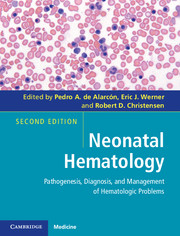Book contents
- Frontmatter
- Contents
- Contributors
- Foreword
- Preface
- 1 A historical review
- Section I Developmental hematology
- Section II Erythrocyte disorders
- Section III Platelet disorders
- 10 Fetal and neonatal immune thrombocytopenia
- 11 Acquired thrombocytopenia
- 12 Congenital thrombocytopenias and thrombocytopathies
- Section IV Leukocyte disorders
- Section V Immunologic disorders
- Section VI Hemostatic disorders
- Section VII Transfusional medicine
- Section VIII Miscellaneous
- Index
- Plate section
- References
12 - Congenital thrombocytopenias and thrombocytopathies
from Section III - Platelet disorders
Published online by Cambridge University Press: 05 February 2013
- Frontmatter
- Contents
- Contributors
- Foreword
- Preface
- 1 A historical review
- Section I Developmental hematology
- Section II Erythrocyte disorders
- Section III Platelet disorders
- 10 Fetal and neonatal immune thrombocytopenia
- 11 Acquired thrombocytopenia
- 12 Congenital thrombocytopenias and thrombocytopathies
- Section IV Leukocyte disorders
- Section V Immunologic disorders
- Section VI Hemostatic disorders
- Section VII Transfusional medicine
- Section VIII Miscellaneous
- Index
- Plate section
- References
Summary
Introduction
Inherited disorders of platelet function or number are rare. The understanding of the etiology of these inherited defects has contributed not only to the knowledge of the specific disease processes but also to the better understanding of platelet physiology. In this chapter we will describe these rare but important inherited defects, some that present in the neonatal period and others whose clinical presentation is delayed to later in life when there is sufficient hemostatic stress to manifest clinical symptoms. Inherited disorders of platetet numbers overlap with bone marrow failure disorders and therefore are also presented in Chapter 5.
Diagnostic approach
Thrombocytopenia occurs in less than 1% of all newborns. However, thrombocytopenia is a common finding in the intensive-care nursery where it is present in up to 25 to 35 percent of admitted infants. The approach to diagnosis and management can be based on the time of onset of thrombocytopenia, on the underlying mechanism, or on whether the thrombocytopenia is due to maternal or infant factors or individualized to the particular infant (1–4). Critical parameters that are common to all these approaches include the severity of thrombocytopenia, the time of onset of thrombocytopenia, the clinical history including maternal history, the health status of the infant, and the presence or absence of other congenital malformations. The approach to the diagnosis of thrombocytopenia must be practical and tailored to the individual infant. We present here a simplified approach based on an algorithm (Fig. 12.1) and a table (Table 12.1) that takes these factors into account, especially the severity of thrombocytopenia and the level of illness of the neonate.
- Type
- Chapter
- Information
- Neonatal HematologyPathogenesis, Diagnosis, and Management of Hematologic Problems, pp. 172 - 208Publisher: Cambridge University PressPrint publication year: 2013

